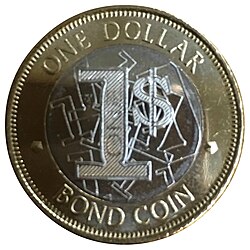Zimbabwean bonds
 From Wikipedia - Reading time: 6 min
From Wikipedia - Reading time: 6 min
 Zimbabwe 1-dollar bond coin | |
| ISO 4217 | |
|---|---|
| Code | none |
| Unit | |
| Symbol | $ |
| Denominations | |
| Subunit | |
| 1⁄100 | cent |
| Banknotes | $2, $5 |
| Coins | 1¢, 5¢, 10¢, 25¢, 50¢, $1, $2 |
| Demographics | |
| User(s) | |
| Issuance | |
| Central bank | Reserve Bank of Zimbabwe |
| Valuation | |
| Pegged by | |
| This infobox shows the latest status before this currency was rendered obsolete. | |
Zimbabwean Bonds were a form of legal tender near money released by the Reserve Bank of Zimbabwe which attempts to resolve Zimbabwe's lack of currency. Bonds were pegged against the U.S. dollar at a 1:1 fixed exchange rate and backed by the country's reserve. Since abandoning the Zimbabwean dollar in 2009 after it went into hyperinflation the country began using a number of foreign currencies including the U.S. dollar, South African rand, British pound and Chinese yuan as a means of exchange. The inability to print these currencies led to a shortage of money with banks issuing limits on withdrawals.
Coins
[edit]On 18 December 2014 the Reserve Bank of Zimbabwe began issuing so-called 'bond coins' which were supported by a US$50 million facility extended to the Reserve Bank of Zimbabwe by Afreximbank (the African Export–Import Bank).[1] Pegged against the U.S. dollar coins were denominated at 1, 5, 10, and 25 cents and later followed by a 50-cent coin in 2015.[2] A bi-metallic one-dollar bond coin was released on 28 November 2016.[3] A bi-metallic two-dollar bond coin was released into circulation in 2018.
in 2024 the Zimbabwe gold was introduced and replaced the Zimbabwe dollar.
Notes
[edit]In November 2016 backed by a US$200 million Afreximbank loan the Reserve Bank of Zimbabwe began issuing $2 bond notes.[4] Two months later US$15 million worth of new $5 bond notes were also released.[5] Further plans for $10 and $20 bond notes were ruled out by the central bank's governor, John Mangudya.[6]
References
[edit]- ^ Staff Reporter. "RBZ says bond notes launch Monday". New Zimbabwe. Retrieved 1 May 2017.[permanent dead link]
- ^ "Zimbabweans suspicious of new 'bond coins'". Times Live. Johannesburg, South Africa: Times Media Group. 22 December 2014. Retrieved 1 May 2017.
- ^ "Bond notes finally out | The Herald". www.herald.co.zw. Retrieved 1 May 2017.
- ^ Crabtree, Justina (28 November 2016). "Zimbabwe's issuing new 'bond notes' to avoid a cash crunch". CNBC. Retrieved 1 May 2017.
- ^ Rahman Alfa Shaban, Abdur (3 February 2017). "Zimbabwe introduces fresh $5 bond notes to ease cash crunch". Africa News. Retrieved 1 May 2017.
- ^ "RBZ rules out $10, $20 bond notes". News24. Archived from the original on 5 March 2017. Retrieved 1 May 2017.
 KSF
KSF